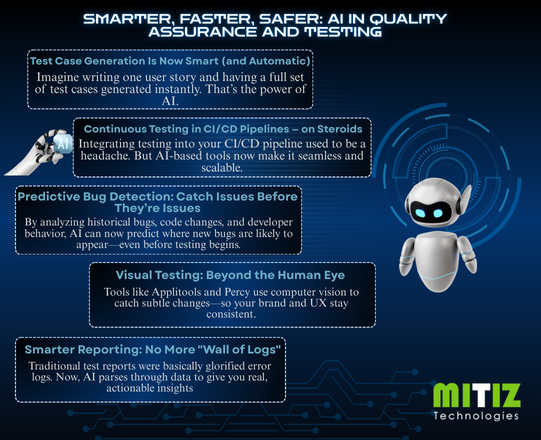
Let’s be honest—testing has always been the part of software development people love to hate. It’s tedious, time-consuming, and often treated like an afterthought. But not anymore.
In 2025, AI is flipping the QA process on its head—making it faster, more accurate, and surprisingly intelligent. At Mitiz Technologies, we’ve adopted AI-driven testing workflows that don’t just save time—they dramatically boost software reliability and security.
Let’s walk through how - 1. Test Case Generation Is Now Smart (and Automatic)
Imagine writing one user story and having a full set of test cases generated instantly. That’s the power of AI.
Modern QA tools like Testim, AccelQ, and Functionize use machine learning to analyze your application flows and auto-generate robust test scenarios.
Covers common paths and edge cases
Learns from past bugs to suggest better tests
Reduces manual writing by 60–70%
At Mitiz, this means our QA teams spend less time writing scripts—and more time interpreting results and improving coverage. 2. Continuous Testing in CI/CD Pipelines—on Steroids
Integrating testing into your CI/CD pipeline used to be a headache. But AI-based tools now make it seamless and scalable.
Tools like Mabl and TestSigma can adapt test scripts in real-time when your UI or API changes.
AI watches how users interact with your app—and adjusts test cases accordingly.
Real-time dashboards show you the most critical failing paths, not just a flood of red flags.
We’ve seen a 45% reduction in post-deployment bugs simply by plugging in AI early in our QA flow. 3. Predictive Bug Detection: Catch Issues Before They’re Issues
This is where things get really futuristic.
By analyzing historical bugs, code changes, and developer behavior, AI can now predict where new bugs are likely to appear—even before testing begins.
AI flags risky commits in version control
Assigns code health scores
Recommends peer reviews for high-risk areas
One of our clients in the healthtech space avoided a critical bug in production—thanks to an AI model flagging a faulty API logic before it was ever tested manually. 4. Visual Testing: Beyond the Human Eye
AI can now detect visual discrepancies on your UI that humans often miss.
Layout shifts
Font mismatches
Component rendering glitches across browsers or devices
Tools like Applitools and Percy use computer vision to catch subtle changes—so your brand and UX stay consistent. 5. Smarter Reporting: No More "Wall of Logs"
Traditional test reports were basically glorified error logs. Now, AI parses through data to give you real, actionable insights:
What caused the failure?
Is it a flaky test or real issue?
How many users could be impacted?
At Mitiz, we feed this data directly to dev teams—so bugs get fixed faster, and feedback loops stay tight. Final Thoughts from Mitiz Technologies
AI in QA isn’t about removing human testers. It’s about amplifying them—giving them tools that think, learn, and optimize alongside the team.
Our approach at Mitiz blends deep technical expertise with cutting-edge AI tools—resulting in software that’s more stable, more secure, and ready for scale.
If you're tired of chasing bugs and delaying releases, maybe it's time to test the way future teams do—with AI on your side.